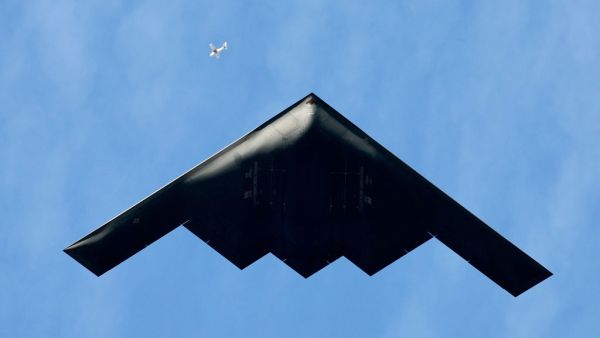Earlier this week, Secretary of Defense Lloyd Austin ordered the USS Gerald R. Ford carrier strike group (CSG) to the eastern Mediterranean to “strengthen Department of Defense posture in the region to bolster regional deterrence efforts…” in response to the terror attacks on Israel. It wasn’t an uncommon move. Moving aircraft carriers and escort ships to trouble spots around the world has been a preferred response option for U.S. presidents since carrier aviation debuted in World War II. Naval forces operate in international waters and airspace without need for basing agreements or overflight permissions.
So what is the Ford CSG, and what is it expected to do?
What is a carrier strike group?
A U.S. Navy CSG is comprised of a nuclear-powered aircraft carrier (in this case, the USS Gerald R. Ford), its embarked carrier air wing (CVW) of strike-fighter aircraft, surveillance aircraft, helicopters, and several combatant warships capable of firing both offensive and defensive missiles. The ships accompanying the carrier are the Ticonderoga-class guided missile cruiser USS Normandy, as well as four Arleigh-Burke-class guided missile destroyers: the USS Thomas Hudner, USS Ramage, USS Carney, and USS Roosevelt. The U.S. Navy maintains two or three CSGs at sea continuously, time-sharing among the U.S. European Command (EUCOM), the U.S. Central Command (CENTCOM), and the U.S. Indo-Pacific Command (INDOPACOM) to protect and sustain U.S. interests around the world and to act as part of the joint force in the event of war. The Navy has 11 active aircraft carriers, each of which deploys as the center of a CSG.
What is the mission of a carrier strike group?
A CSG is optimized for sea control and power projection. “Sea control” means establishing exclusive use of a defined region of ocean for a discrete period of time and exercising dominance from the seafloor to the airspace above. It must be able to track and destroy adversary submarines, surface ships, aircraft, and missiles within this area. Gaining sea control allows the strike group to project power ashore. It does so by employing several squadrons of fighter-attack aircraft, armed with precision guided munitions and bombs. It also does so through the offensive power of the Tomahawk missiles carried by its cruisers and destroyers, which can be fired at both land targets and ships at unclassified ranges of about 1,000 nautical miles. Power projection is a key part of the nation’s forward-based conventional deterrence posture, forcing potential aggressors to account for such power.
Why was the Gerald R. Ford ordered to the eastern Mediterranean?
Austin ordered the Ford to the eastern Mediterranean to reassure Israel of our continuing support for its security, and to signal to others in the region (Iran, Russia, Syria, Hezbollah) that the United States is prepared to use force to protect its interests. The Ford CSG also employs sophisticated airborne and seaborne intelligence capabilities, including signals and communications intercept, and it is likely that relevant activity is being reported to the Israelis. Additionally, the E-2D Hawkeye airborne radar surveillance platform likely monitors air and missile activity in southern Lebanon and Syria to provide Israel with additional early warning capability. Moreover, the CSG could be there to support U.S. Special Operations forces if they are at some point called upon to rescue reported American hostages.
Why was the Ford CSG in the Mediterranean in the first place?
America enjoys the benefits of friendly border nations and huge oceans separating us and potential adversaries. But those oceans also separate us from some key security and economic interests. It is the Navy’s legal mission to tend to both, and in order to do so it must be forward deployed. This is why the Navy maintains two or three CSGs at sea at a time, focused on parts of the world where our interests lie. The Navy maintains these forward forces to deter aggression, assure allies, and respond to crises, each of which is more effectively pursued by forces already in the region rather than having to mobilize from U.S bases.
With the ongoing war in Ukraine, growing tensions with China in the Pacific, and now the brewing conflict in the Middle East, it should be clear that the U.S. Navy needs a fleet capable of meeting the demands of continuous and simultaneous operations in dispersed locations. The debt limit agreement reached earlier this year, however, limits defense budget growth to levels below inflation, and there seems to be little appetite on Capitol Hill to make tough decisions within the defense budget to privilege growing the Navy.
Nevertheless, being able to respond to crises from forces already in the region is crucial to our national security. The movement of the Ford CSG this week clearly shows this.
Click here for more coverage of the war in Israel.






Please note that we at The Dispatch hold ourselves, our work, and our commenters to a higher standard than other places on the internet. We welcome comments that foster genuine debate or discussion—including comments critical of us or our work—but responses that include ad hominem attacks on fellow Dispatch members or are intended to stoke fear and anger may be moderated.
With your membership, you only have the ability to comment on The Morning Dispatch articles. Consider upgrading to join the conversation everywhere.